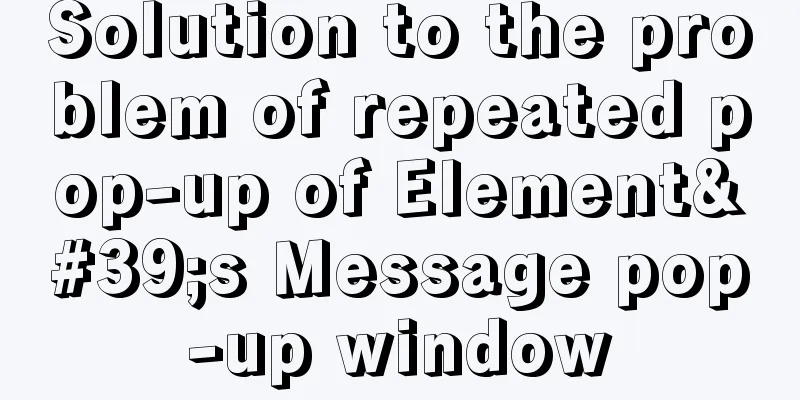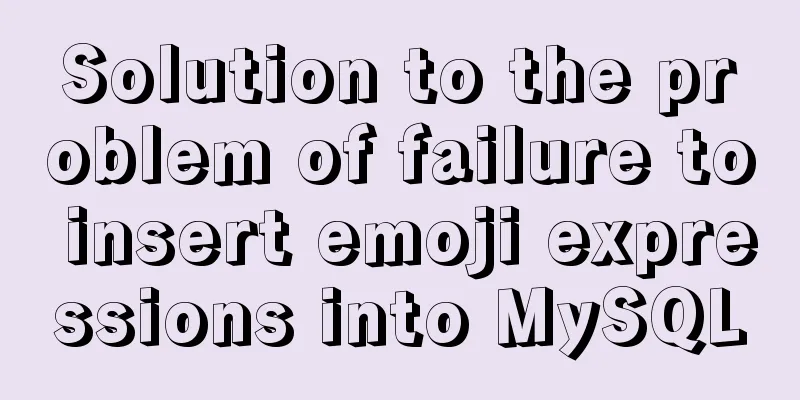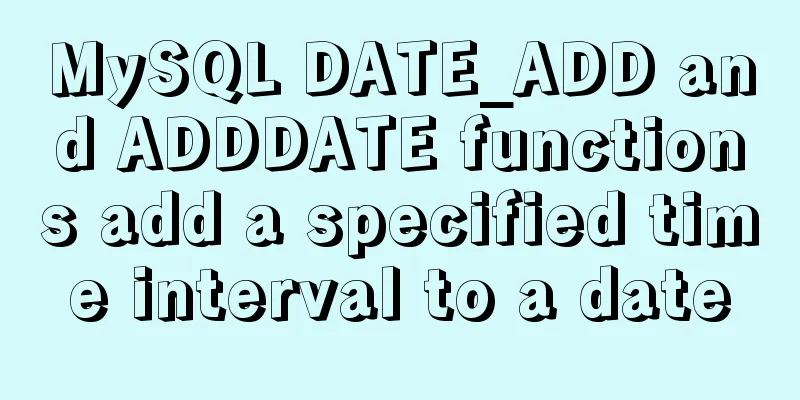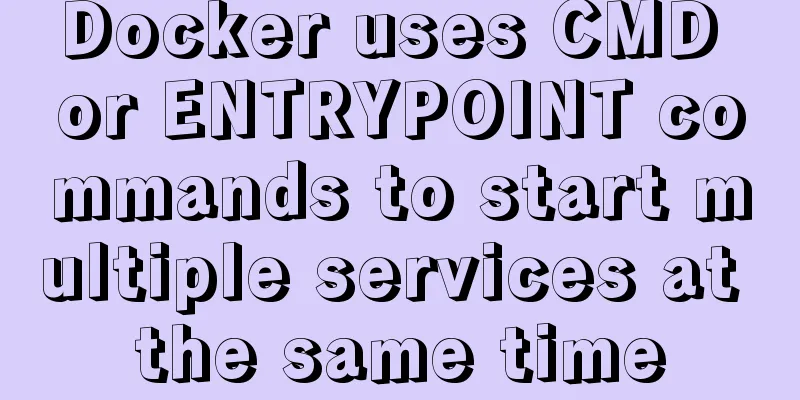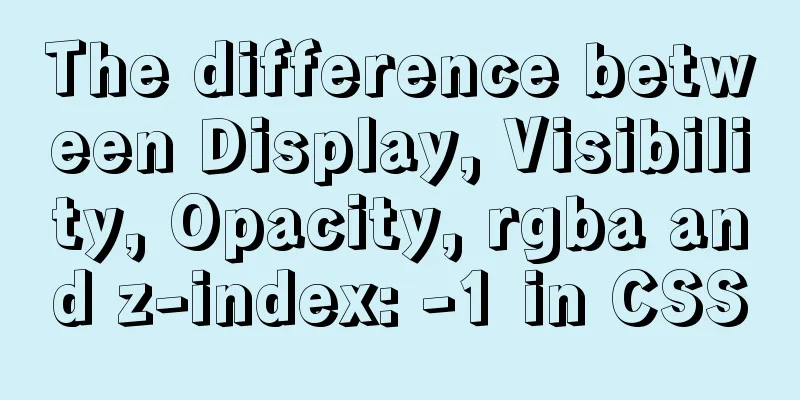Example of deploying MySQL on Docker
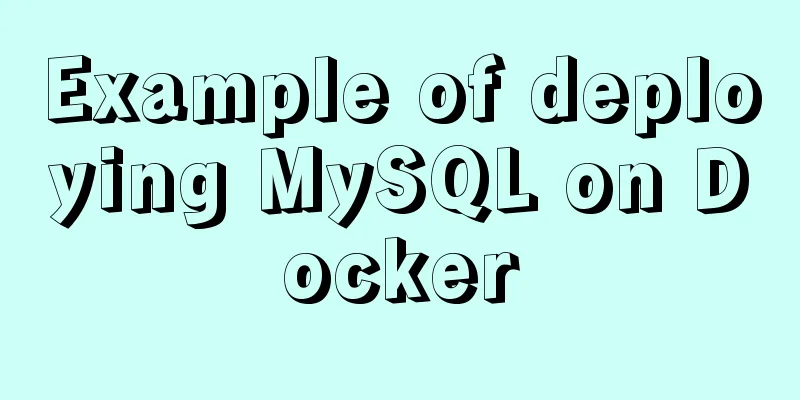
|
The concept of container cloud is very popular now. Many companies now deploy MySQL on containers. Before we start today's content, let's take a look at the concept of container cloud. 1 What is container cloud?To understand the concept of container cloud, you first need to understand containers. When introducing containers, you need to introduce virtual machines for comparison. Virtual Machine: VMware or Virtual BoX, a virtual machine, must have been used by everyone in daily work. It is software that simulates computer operating systems. You can install Virtual BoX software on a Windows computer, and then install Linux operating systems such as Centos or Ubuntu on Virtual Box, so that you can run multiple types of operating systems on one machine, making our development and testing work very convenient. The disadvantage of virtual machines is that they consume a lot of resources. Each virtual machine requires separate allocation of memory and disk space, and also consumes CPU resources and a lot of underlying hardware resources. If you just run a hello world program on it, it will cause a lot of waste of resources. container: The emergence of containers is to solve this problem. It is a lighter and more flexible virtualization processing technology that packages all the resources required by an application together, including the application code source code, dependent libraries and operating system, which allows the application to run easily anywhere without being restricted by the environment. Compared with virtual machines, containers are lighter, more portable, lower cost, and more efficient. Container cloud can be understood as container technology services on the cloud. 2 Introduction to DockerDocker is an open source application container engine. We can understand it as a tool. It is developed based on the Go language and is compatible with the Apache 2.0 protocol. It can package applications and their dependencies (such as configuration files, etc.) into containers. In addition, it is compatible with a variety of environments and can be deployed on laptops, internal servers, public clouds or private clouds. It has good portability and flexible deployment, solving compatibility issues in a variety of environments. Docker includes three basic concepts: Image
These three parts make up the entire life cycle of Docker, as shown in the figure above. The Docker image contains a file system, similar to a virtual machine image, and is a read-only template. The Docker container is instantiated from the image, which is very similar to the object-oriented concept we learned. We can imagine the image as a class and the container as an object after the class is instantiated. This makes it very easy to understand the relationship between the image and the container. Docker repository: Similar to the code repository, it is the place where Docker stores image files centrally This relationship can be expressed more clearly as:
Let's look at the installation of Docker: 1. Install the required packages, where yum-utils provides yum-config-manager, and the device mapper storage driver requires device-mapper-persistent-data and lvm2 yum install -y yum-utils yum install -y device-mapper-persistent-data yum install -y lvm2 2. Set up a stable docker repository
yum-config-manager \
--add-repo \
http://mirrors.aliyun.com/docker-ce/linux/centos/docker-ce.repo3. Install Docker Engine-Community yum install docker-ce docker-ce-cli cotainerd.io At this point, Docker is installed but not started by default. The docker user group has been created, but there are no users in this user group. 3 Install MySQL using dockerIt is very simple to install the MySQL service using Docker. The overall steps are as follows: 1. Download MySQL image You can log in to the official docker repository to find the mysql image at the following URL: https://hub.docker.com/_/mysql?tab=tags You can also use the docker command to download the MySQL image directly yum pull mysql:5.7.16 The above command indicates that we want to download the image of MySQL5.7.16. If we do not write the last version number, the latest MySQL version image will be pulled by default 2. Start MySQL. After the pull is complete, we can start the MySQL instance with the following command: docker run -itd --name mysql_5716 -p 3306:3306 -e MYSQL_ROOT_PASSWORD=yeyazhou mysql_5716 in: -i: Run the container in interactive mode -t: reallocate a pseudo input terminal for the container -d: Run the container in the background -p 3306:3306: Maps the container service's port 3306 to the host's port 3306. External hosts can directly access the MySQL service through the host's ip:3306. MYSQL_ROOT_PASSWORD=yeyazhou: Set the password of the MySQL service root user. 3. Check the running status of the container container id: container id Other information includes the source image of the container, creation time, status, port mapping information, container name, etc. 4. Enter the container to view First we use the command to enter the interactive command line of the container: docker exec -it mysql_5716 /bin/bash The results are as follows root@8c388ccfb761:/# ls -l total 72 drwxr-xr-x 1 root root 4096 Nov 8 2016 bin drwxr-xr-x 2 root root 4096 Sep 12 2016 boot drwxr-xr-x 5 root root 360 Aug 11 11:41 dev drwxr-xr-x 2 root root 4096 Nov 8 2016 docker-entrypoint-initdb.d lrwxrwxrwx 1 root root 34 Nov 23 2016 entrypoint.sh -> usr/local/bin/docker-entrypoint.sh drwxr-xr-x 1 root root 4096 Aug 11 11:41 etc drwxr-xr-x 2 root root 4096 Sep 12 2016 home drwxr-xr-x 1 root root 4096 Nov 8 2016 lib drwxr-xr-x 2 root root 4096 Nov 4 2016 lib64 drwxr-xr-x 2 root root 4096 Nov 4 2016 media drwxr-xr-x 2 root root 4096 Nov 4 2016 mnt drwxr-xr-x 2 root root 4096 Nov 4 2016 opt dr-xr-xr-x 104 root root 0 Aug 11 11:41 proc drwx------ 1 root root 4096 Aug 11 11:49 root drwxr-xr-x 1 root root 4096 Nov 8 2016 run drwxr-xr-x 2 root root 4096 Nov 4 2016 sbin drwxr-xr-x 2 root root 4096 Nov 4 2016 srv dr-xr-xr-x 13 root root 0 Jul 19 02:47 sys drwxrwxrwt 1 root root 4096 Aug 11 11:41 tmp drwxr-xr-x 1 root root 4096 Nov 23 2016 usr drwxr-xr-x 1 root root 4096 Nov 8 2016 var You can see that the container interactive command line has been entered. The string after the @ symbol in the previous root@8c388ccfb761 is our container ID. 5. Use the connection string to connect to MySQL root@8c388ccfb761:/usr/local# mysql -uroot -pyeyazhou -h127.0.0.1 mysql: [Warning] Using a password on the command line interface can be insecure. Welcome to the MySQL monitor. Commands end with ; or \g. Your MySQL connection id is 16 Server version: 5.7.16 MySQL Community Server (GPL) Copyright (c) 2000, 2016, Oracle and/or its affiliates. All rights reserved. Oracle is a registered trademark of Oracle Corporation and/or its affiliates. Other names may be trademarks of their respective owners. Type 'help;' or '\h' for help. Type '\c' to clear the current input statement. mysql> show databases; +--------------------+ | Database | +--------------------+ | information_schema | |mysql | | performance_schema | |sys| +--------------------+ 4 rows in set (0.00 sec) 6. Start another MySQL container [root@VM-0-14-centos ~]# docker run -itd -p 3307:3306 --name mysql_5716_2 -e MYSQL_ROOT_PASSWORD=yeyazhou mysql:5.7.16 e5e0f9a14462261d01307c4d0891587acce90e4ffd33e434878f311bf98d4f22 [root@VM-0-14-centos ~]# docker ps CONTAINER ID IMAGE COMMAND CREATED STATUS PORTS NAMES e5e0f9a14462 mysql:5.7.16 "docker-entrypoint.s..." 8 seconds ago Up 6 seconds 0.0.0.0:3307->3306/tcp mysql_5716_2 8c388ccfb761 mysql:5.7.16 "docker-entrypoint.s..." 25 hours ago Up 25 hours 0.0.0.0:3306->3306/tcp mysql_5716 The above is the details of the example of deploying MySQL on docker. For more information about deploying MySQL on docker, please pay attention to other related articles on 123WORDPRESS.COM! You may also be interested in:
|
<<: Detailed explanation of using backgroundImage to solve the image carousel switching
>>: Handwriting implementation of new in JS
Recommend
Perfect solution to MySQL common insufficient memory startup failure
1. If MySQL is not started successfully, check th...
How to quickly deploy Redis as a Docker container
Table of contents getting Started Data storage Co...
CSS and JS to achieve romantic meteor shower animation
1. Rendering 2. Source code HTML < body > &...
Click the toggle button in Vue to enable the button and then disable it
The implementation method is divided into three s...
Analysis and opinions on the design structure of the large picture on the homepage of Taobao Mall (picture)
After I analyzed the Taobao details page last time...
JS ES new features template string
Table of contents 1. What is a template string? 2...
Summary of using MySQL isolation columns and prefix indexes
Table of contents Isolate Data Columns Prefix Ind...
How to quickly repair corrupted MySQL database files using the myisamchk and mysqlcheck tools
Because the server's database hard disk space...
An example of how to quickly deploy web applications using Tomcat in Docker
After learning the basic operations of Docker, we...
Nginx domain forwarding usage scenario code example
Scenario 1: Due to server restrictions, only one ...
MySQL 8.0.18 stable version released! Hash Join is here as expected
MySQL 8.0.18 stable version (GA) was officially r...
How to use JavaScript strategy pattern to validate forms
Table of contents Overview Form validation withou...
MySQL query duplicate data (delete duplicate data and keep the one with the smallest id as the only data)
Development Background: Recently, I am working on...
WeChat Mini Program to Implement Electronic Signature
This article shares the specific code for impleme...
Mac+IDEA+Tomcat configuration steps
Table of contents 1. Download 2. Installation and...


